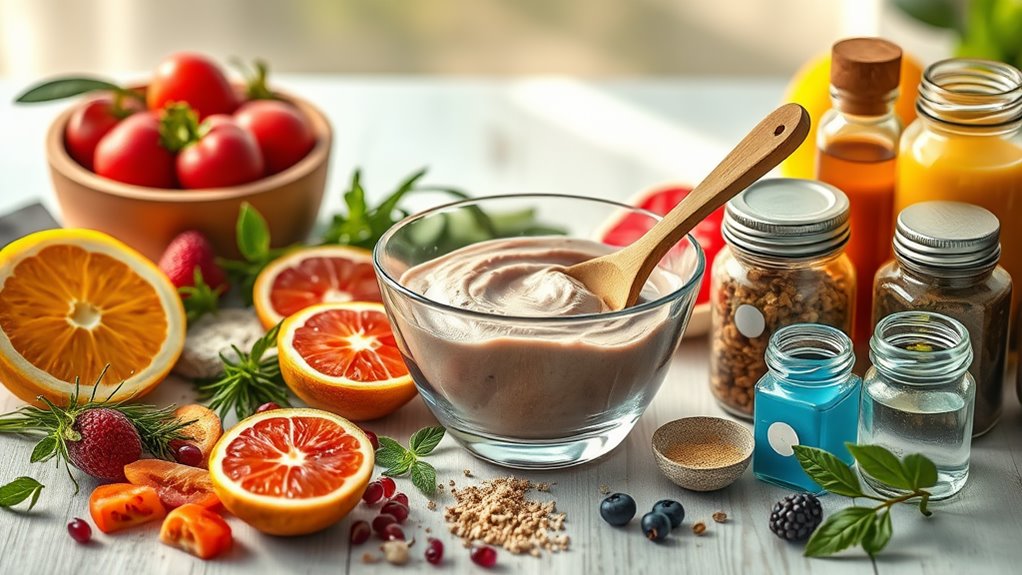Why DIY Face Masks Are Better Than Store-Bought
When it comes to skincare, DIY face masks have distinct advantages over store-bought options. You can trust the natural ingredients, often found right in your kitchen, to nourish your skin without the added chemicals. Plus, making your own masks can be cost-effective and tailored to your specific needs. Curious about how these benefits stack up against commercial products? Let’s explore the compelling reasons to embrace homemade skincare.
Key Takeaways
- DIY face masks use natural ingredients, avoiding harmful additives found in many store-bought options, promoting healthier skin.
- They are cost-effective, utilizing common household items, saving money compared to expensive commercial products.
- Customization allows tailoring masks to specific skin needs, enhancing effectiveness for individual concerns like dryness or oiliness.
- Creating DIY masks reduces packaging waste, aligning with eco-friendly values and minimizing environmental impact.
- The hands-on approach encourages experimentation, fostering creativity and a deeper understanding of personal skincare needs.
Natural Ingredients You Can Trust
When it comes to DIY face masks, the power of natural ingredients can’t be overstated. You’ve got a treasure trove of options right in your kitchen.
Ingredients like honey, known for its antibacterial properties, can hydrate and soothe your skin. Avocado provides essential fatty acids, promoting elasticity and nourishment.
Don’t overlook oatmeal; it’s fantastic for calming irritation and exfoliating gently. By using fresh, organic components, you’re not only avoiding harmful additives but also customizing your masks for your unique skin needs.
Plus, with DIY face masks, you can experiment with combinations to find that perfect blend. Trusting natural ingredients empowers you to take control of your skincare, making every application a step toward mastery.
Embrace the art of DIY!
Cost-Effectiveness of DIY Masks
When you consider making DIY face masks, the cost-effectiveness becomes clear.
You can use lower material costs and create reusable options that help reduce waste.
Plus, customizing your ingredients can save you even more money while tailoring the mask to your specific needs.
Lower Material Costs
Making your own face masks can save you a significant amount of money compared to buying them from stores. When you DIY, you control the material costs, often sourcing fabrics and supplies at lower prices than pre-packaged masks.
Many household items, like old T-shirts, bandanas, or cotton fabric remnants, can be repurposed into effective masks. This not only cuts costs but also allows you to create multiple masks without straining your budget.
Additionally, by investing in a few basic sewing supplies, you can produce high-quality masks tailored to your preferences. This approach empowers you to prioritize both your health and your finances, giving you the freedom to craft masks that meet your needs without breaking the bank.
Reusable and Sustainable
While store-bought masks often end up in the trash after a single use, DIY masks offer a more sustainable option. By creating your own masks, you can incorporate reusable materials, reducing waste and promoting environmental stewardship.
You’re able to wash and repurpose these masks, extending their lifespan considerably compared to disposable alternatives. This not only saves money in the long run but also minimizes your ecological footprint.
With each reuse, you lessen the demand for single-use products, contributing to a more sustainable lifestyle. Embracing DIY masks empowers you to take control of your skincare routine while supporting eco-friendly practices.
Ultimately, you’ll find that cultivating this habit aligns with both your wallet and your values.
Customizable Ingredients Savings
Not only can DIY masks be cost-effective, but they also allow you to customize ingredients based on your skin’s specific needs.
This personalization not only enhances effectiveness but also helps you save money.
Here are some ingredients you can easily incorporate:
- Honey for hydration
- Oatmeal to soothe irritation
- Avocado for nourishment
- Yogurt to exfoliate gently
- Essential oils for targeted benefits
Customization for Individual Skin Needs
When it comes to skincare, customizing your face mask to address your specific skin concerns can make all the difference. You know your skin better than anyone, so why not tailor your mask to fit its unique needs?
If you struggle with dryness, incorporate hydrating ingredients like honey or avocado. For oily skin, opt for clay or charcoal to absorb excess oil. Got sensitive skin? Soothing elements like oatmeal or chamomile can help calm irritation. Additionally, including proven ingredients known for fading dark spots can enhance the effectiveness of your DIY mask.
Environmental Impact of Homemade Products
When you make your own face masks, you cut down on packaging waste that often comes with store-bought options.
You can also choose sustainable materials that align with your eco-friendly values.
Plus, creating these masks at home typically means a lower carbon footprint compared to mass-produced products.
Reduced Packaging Waste
How much waste can you save by opting for DIY face masks instead of store-bought ones? The difference is significant.
When you create your own masks, you cut down on excessive packaging that often ends up in landfills. Here are some key benefits of choosing homemade:
- No plastic wrappers or boxes cluttering your space
- Ability to reuse containers or materials you already have
- Reduced carbon footprint from manufacturing and shipping
- Less reliance on single-use products
- Encouragement of sustainable practices in your routine
Sustainable Material Choices
Choosing sustainable materials for your DIY face masks not only benefits your skin but also the planet. Opt for organic cotton, bamboo, or hemp, as these materials are biodegradable and free from harmful chemicals.
You can also repurpose fabric scraps from old clothing, giving them a new life while reducing waste. When you select natural dyes or essential oils, you enhance your mask’s efficacy without introducing synthetic chemicals that could irritate your skin.
Consider the sourcing of your materials—support local artisans or eco-friendly brands to minimize your environmental footprint.
Lower Carbon Footprint
While many store-bought face masks contribute to a significant carbon footprint due to manufacturing and shipping processes, creating your own at home can drastically reduce environmental impact.
By choosing to make your face masks, you’ll not only embrace sustainability but also contribute to a healthier planet. Here’s how DIY masks lower your carbon footprint:
-
No industrial emissions****: You eliminate harmful gases produced during manufacturing.
-
Local sourcing: Utilize materials from local suppliers, cutting down transportation emissions.
-
Less plastic waste****: Homemade masks often require fewer plastic components.
-
Reduced packaging: You avoid excess packaging materials used in store-bought products.
-
Empowerment: You gain control over the sustainability of your materials and processes.
Embrace the power of DIY and make a difference!
Avoiding Harmful Chemicals in Store-Bought Options
As you explore store-bought face masks, it’s crucial to pay attention to the ingredients list, since many products contain harmful chemicals that can irritate your skin or disrupt your health.
Common culprits include parabens, sulfates, and synthetic fragrances, which can lead to allergic reactions or long-term skin damage. By choosing masks loaded with these additives, you compromise the integrity of your skincare routine.
Instead, familiarize yourself with natural alternatives like aloe vera, honey, and essential oils, which nourish your skin without the risk of adverse effects.
Prioritize your health by opting for products labeled as free from harmful chemicals. This awareness empowers you to make informed choices, ensuring you treat your skin with the care it deserves.
The Satisfaction of Creating Your Own Skincare
Creating your own skincare can be a deeply rewarding experience that connects you to the ingredients you use. When you craft your own face masks, you gain not just a product, but a sense of accomplishment and mastery.
Here are some benefits you’ll enjoy:
-
Personalization: Tailor the mask to your unique skin type and needs.
-
Creativity: Experiment with different textures, scents, and colors.
-
Mindfulness: Engage in a calming, meditative process that enhances your self-care ritual.
-
Sustainability: Reduce waste by using natural ingredients instead of plastic-packaged products.
-
Empowerment: Take control of your skincare routine and understand what works for you.
Additionally, creating your own face masks allows you to incorporate ingredients that can help stop aging skin, promoting a youthful glow while ensuring you avoid harmful additives.
Easy Access to Ingredients at Home
You’ll find that many common ingredients for DIY face masks are probably already in your kitchen or bathroom. This easy access not only saves you time but also guarantees you’re using fresh, natural components tailored to your skin’s needs. Incorporating natural ingredients into your routine can also help target specific skin concerns like dark spots. Here’s a quick reference table of popular ingredients and their benefits:
| Ingredient | Benefits | Skin Type |
|---|---|---|
| Honey | Moisturizing, antibacterial | All skin types |
| Yogurt | Soothing, exfoliating | Dry or sensitive skin |
| Oatmeal | Calming, anti-inflammatory | Acne-prone skin |
| Avocado | Hydrating, rich in vitamins | Dry or mature skin |
Unique Recipes for All Skin Types
Everyone loves a good DIY face mask, especially when you can customize recipes for your specific skin type.
Tailoring your masks not only enhances their effectiveness but also guarantees a luxurious experience.
Here are unique recipes for different skin types:
-
Oily Skin: Mix clay, tea tree oil, and apple cider vinegar for a purifying mask.
-
Dry Skin: Blend avocado, honey, and yogurt to hydrate and nourish.
-
Sensitive Skin: Combine oatmeal, honey, and chamomile tea for a soothing effect.
-
Combination Skin: Use cucumber, aloe vera, and lemon juice for balance.
-
Aging Skin: Mix banana, olive oil, and vitamin E for a rejuvenating treatment.
These tailored recipes let you master your skincare routine, guaranteeing your face feels revitalized and radiant.
The Joy of Personalization and Experimentation
Customizing your skincare routine opens up a world of exploration and creativity. With DIY face masks, you’re not just following a recipe; you’re crafting a unique blend tailored to your skin’s needs.
You can experiment with ingredients like honey, avocado, or charcoal, discovering what truly works for you. This hands-on approach allows you to adjust textures and scents, ensuring each mask is a sensory delight.
You’ll gain insights into how different components interact, enhancing your mastery over your skincare. Plus, the thrill of trial and error can lead to unexpected, delightful discoveries.
Frequently Asked Questions
How Long Do DIY Face Masks Typically Last Once Made?
DIY face masks typically last about 15 to 30 minutes once made. You should use them immediately for the best results, as ingredients can lose potency and effectiveness if left sitting too long.
Can DIY Masks Cause Allergic Reactions?
Yes, DIY masks can cause allergic reactions, especially if you use unfamiliar ingredients. Always patch-test a small area on your skin before applying a mask to your face, ensuring it’s safe for your skin type.
What Tools Are Needed to Create DIY Face Masks?
To create DIY face masks, you’ll need basic tools like scissors, a sewing machine or needle and thread, fabric, and a ruler. Gather these materials to guarantee your mask-making process runs smoothly and effectively.
How Often Should I Use a DIY Face Mask?
You should use a DIY face mask once or twice a week, depending on your skin type. This frequency helps maintain hydration and balance without overwhelming your skin, ensuring ideal results and a healthy glow.
Are There Any Specific Storage Tips for Homemade Masks?
Store your homemade masks in an airtight container in the fridge for up to a week. Always label them with the date, and discard any mask that shows signs of spoilage, like discoloration or odor.
Conclusion
To sum up, DIY face masks are a fantastic choice for your skincare routine. You get to use natural ingredients you trust, save money, and tailor recipes to meet your unique skin needs. By making your own masks, you also reduce environmental waste and steer clear of harsh chemicals. Plus, there’s a satisfying joy in creating something just for you! So, why not plunge into the world of DIY skincare and explore the endless possibilities? Your skin will thank you!





